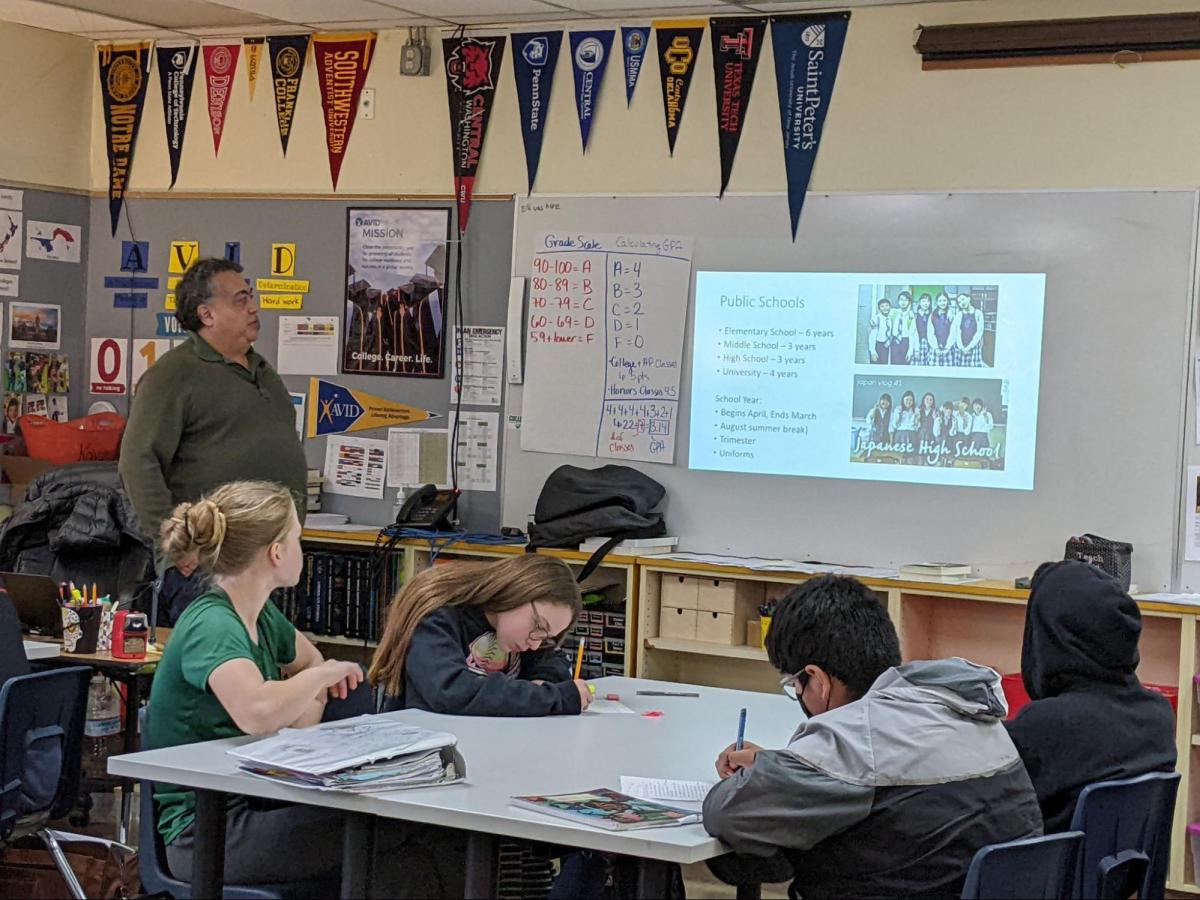District Office
20256 Grim Road NE
Aurora, Oregon 97002
Phone number: (503) 678‑7100
20256 Grim Road NE
Aurora, OR 97002
Phone: (503) 678-7100
Fax: (503) 386-4659

(If you missed Part I, view check it out now!)
By Jillian Daley
North Marion Middle School students are saying hello to their new sister school in Japan, Miyoshi Junior High School (MJHS).
That’s the power of the Middle School’s new elective, Advancement Via Individual Determination (AVID), inspiring students to explore possibilities, offering a dynamic focus on college and career that includes connecting with cultures, countries, and communities worldwide. One of the key aspects to inspiring students is to invite guest speakers, with a particularly special one coming by to finish off the school year.
This past March 17, AVID Elective Teacher Chelsea Landry brought in a guest speaker who is helping her students reach across the globe, North Marion School Board Director Bill Graupp. Graupp shared information about Japan and about the Middle School’s new sister school there, an opportunity made possible because of his hard work. MJHS, established in 1898, is tucked into the Chugoku Mountains of Northern Hiroshima, a city on Japan’s largest and most populous island, Honshu. Students have already been writing letters to their new pen pals across the ocean. (View a short video of School Board Director Bill Graupp’s presentation!)
During Graupp’s presentation, Landry asked students to keep one question in mind: How is life in Japan different from life in Oregon? The students were so engaged that they peppered Graupp with questions about Japan’s different way of life throughout the presentation.
Graupp, who has family in Japan, visited two or three times a year prior to the COVID-19 pandemic and knows a great deal about the country. He said that it is twice as far away as New York.
About 126 million people live on the four islands of Japan, about half as many as in the United States but in an area about the size of California. That small area actually has more active volcanoes than anywhere else in the world. But their rumbles don’t slow down the populace.
A network of bullet trains called shinkansen that can travel up to 190 mph, serve as a boon to travelers and commuters alike. Seventh-grade Katelynn Buchnoff was so impressed that she remarked that Oregon could use such a network to make it easier to travel to the coast.
Graupp agreed, and he told the students that because the trains are so fast “a driver of a shinkansen is considered a national hero.”
A shinkansen is the best way to travel between Japan’s two capitals, Kyoto (the old one), and Tokyo, (the current one). Having dual capitals prompted seventh-grader Danika Cox to inquire about this unusual move. Graupp explained that the change in capitals occurred because of a commander, or Shogun. (The Shogun relinquished his power to an emperor who already lived at the site of the new capital.)
People may know more about the food than the geography. But they may not know that the presentation of food is especially important, and Graupp shared photos of some of the edible artwork, common even in local restaurants, such as rice balls shaped into pandas with seaweed eyes and ears, which set off a chorus of “awws” from the whole classroom.
Of course, it wasn’t the volcanic geography, bullet trains, adorable plating of delectable dishes, or even the three alphabets (two phonetic, one a series of symbols representing meanings) that caught the students’ attention.
Students were most fascinated by everything about their sister school, MJHS, down to the fact that it was called a “junior high school” instead of a “middle school.” Landry says her students have been quite enthusiastic about the letters they've written to their pen pals and just the idea of knowing other students from afar.
In fact, anything related to any school in Japan fascinated the Landry's class, including that students are expected to learn English. The teens were especially interested in the uniforms.
Jedediah McGee noted, “One thing that is different in Japan is that they are required to wear uniforms” in school.
“Yes, absolutely, all through high school they are required,” Graupp said.
Another subtopic under the hot subject of education was college. Seemingly unusual for middle schoolers, it actually makes a lot of sense because of AVID’s focus on the future. Landry told her students that they could try a study abroad program in college, allowing them to attend school in another country for a semester, such as Japan.
“Japan has such a good educational system; that would be a really good place to go study abroad,” Landry noted.
The students wanted to know if students were required to attend college, and Graupp said that it is expected.
“Why is going to a university expected?” seventh-grader Ella Stoddard asked.
“They live in a different culture,” Graupp told her. “If you graduate with a high school degree in Japan, you’re going to work in your parents' restaurant or city services, and that’s fine. But if you want a job accelerating up a pay scale, university is considered required. It’s built into their culture and system.”
Landry said that even after so many questions the students can’t wait to learn more about Japan and about their new sister school, MJHS. Just like that, another door is opened for the students; they’re learning there is so much to explore all over the world.
To share stories on the North Marion School District, email Communications Specialist Jillian Daley at jillian.daley@nmarion.k12.or.us.